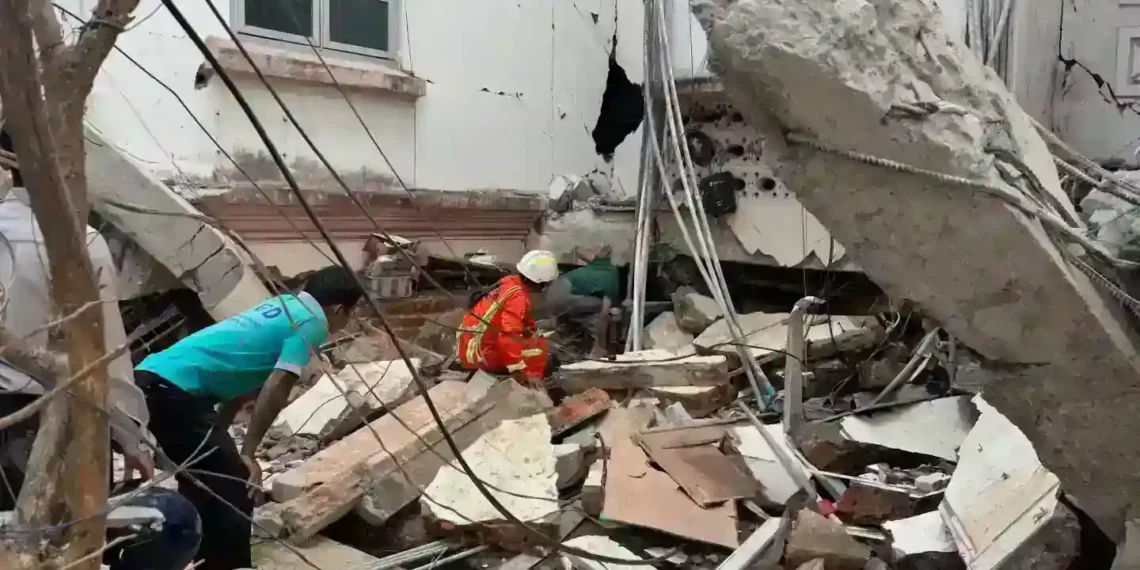Myanmar Earthquake Death Toll Surpasses 1,000, More Casualties Expected as Rescue Efforts Intensify
A devastating 7.7 magnitude earthquake struck Myanmar on Friday, claiming over 1,000 lives as rescue teams continue to dig through the rubble of collapsed buildings. The quake, which hit near Myanmar’s second-largest city, Mandalay, sent shockwaves through the country already grappling with the impacts of a brutal civil war.
As of Saturday, the official death toll stands at 1,002, with at least 2,376 people injured and 30 still missing. The government has acknowledged that these numbers could rise further as more bodies are discovered and detailed reports come in. The sheer scale of the disaster has intensified fears of further casualties, particularly given the ongoing difficulties in navigating the conflict zones that complicate rescue operations.
Myanmar, long embroiled in political unrest, is currently in the midst of a deadly civil war, making both movement and relief efforts challenging. This conflict has already created a humanitarian disaster, with millions displaced and widespread destruction in various regions. The earthquake’s impact is made even worse by the already fragile state of the country’s infrastructure, which is ill-equipped to handle such a large-scale disaster.
The earthquake struck at midday on Friday, with the epicenter near Mandalay. It was followed by several aftershocks, including one that measured a powerful 6.4 magnitude. The quake caused widespread destruction, toppling buildings, buckling roads, and collapsing bridges. One of the most concerning incidents was the rupture of a dam, which could have long-term consequences for surrounding areas.
In Naypyidaw, Myanmar’s capital, efforts to repair roads were underway on Saturday, but many areas still lacked power, and communication services, including phone and internet, remained down. The earthquake took down several government buildings, including residential units for civil servants, but authorities have blocked off affected areas.
The earthquake also sent tremors across the border into Thailand, where the greater Bangkok area, home to over 17 million people, was shaken. Authorities reported six deaths and at least 26 injuries, with 47 people still missing, mostly from a construction site near the capital’s bustling Chatuchak market. Heavy machinery has been brought in to clear rubble, though hope is fading for those still trapped under the debris.
One local resident, Naruemol Thonglek, desperately searched for her partner and friends. “I was praying they survived, but when I saw the destruction, I couldn’t believe it. Where could they be?” she said, tears streaming down her face.
Myanmar lies along the Sagaing Fault, a major tectonic plate boundary that has caused previous earthquakes in the region. Seismologist Brian Baptie explains that a section of the fault ruptured, causing intense shaking in an area where many people live in vulnerable structures like unreinforced brick and timber buildings. This made the consequences of the quake particularly disastrous.
“Earthquakes in densely populated areas with poorly built structures often result in catastrophic outcomes,” Baptie added.
The earthquake’s timing could not have been worse for Myanmar, which is already dealing with the humanitarian fallout of its ongoing civil war. In the hardest-hit regions, blood supplies are running low, and aid is desperately needed. Despite Myanmar’s government’s previous reluctance to accept foreign aid, the military leader, Min Aung Hlaing, announced that the country is now ready to accept international assistance.
Yet, as rescue operations intensify, military actions continue. According to humanitarian groups, Myanmar’s military forces have launched airstrikes in northern Kayin and southern Shan states even after the earthquake struck. These regions, which border Mandalay, were already heavily affected by the conflict. Dave Eubank, a former U.S. Special Forces soldier, who now leads a humanitarian group in the area, described the situation: “The military has already destroyed most villages, so the earthquake didn’t add much damage there, but they continue to attack.”
In Shan, an airstrike just minutes after the earthquake killed seven militia members and caused further destruction. The continuous conflict complicates aid efforts and makes large parts of the country inaccessible to relief workers.
The scope of the damage in Myanmar is staggering, and the humanitarian needs are mounting by the hour. Haider Yaqub, Myanmar director for Plan International, said, “The destruction is unlike anything we’ve seen before. The needs are beyond anything we can prepare for.”
Satellite images of Naypyitaw International Airport showed the collapse of the air traffic control tower, which was destroyed by the earthquake. This disruption further delayed aid and rescue flights, with international teams rerouted to Yangon instead of Mandalay or Naypyitaw.
In the aftermath of the quake, Myanmar has received offers of aid from several countries. China, Russia, India, Malaysia, and South Korea are among the first to send rescue teams and humanitarian supplies. China has sent over 135 rescuers, while Russia has flown in 120 personnel. The U.N. has also allocated $5 million in emergency funds to begin relief efforts.
The United States, which has been criticized for cutting foreign aid during the Trump administration, has pledged support, although experts question how much assistance will be available in light of these reductions.
As rescue teams continue to search through the debris, the full extent of the damage in Myanmar remains unclear. The country is facing an unprecedented disaster, and the road to recovery will be long and difficult, especially given the ongoing civil war and fragile political situation. Still, the outpouring of international aid and solidarity may offer a glimmer of hope in the face of such overwhelming destruction.
This article was rewritten by JournosNews.com based on verified reporting from trusted sources. The content has been independently reviewed, fact-checked, and edited for accuracy, neutrality, tone, and global readability in accordance with Google News and AdSense standards.
All opinions, quotes, or statements from contributors, experts, or sourced organizations do not necessarily reflect the views of JournosNews.com. JournosNews.com maintains full editorial independence from any external funders, sponsors, or organizations.
Stay informed with JournosNews.com — your trusted source for verified global reporting and in-depth analysis. Follow us on Google News, BlueSky, and X for real-time updates.














